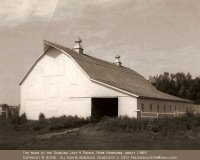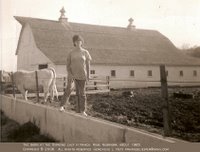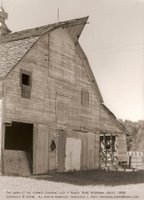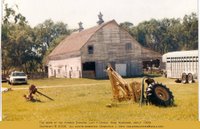Memories of a wonderful barn
I was blessed with a wonderful barn when I was a child, and because I remember that barn so fondly, I still have an affection for barns. (You may have noticed that barns are a recurring theme on this blog.)
I would estimate that the barn of my childhood was built before 1920, and possibly as early as 1900. [See the comment below from Hills of KS.] It was part of the headquarters of the A & D Cattle Company, a ranching operation in southern Rock County, Nebraska, located just a mile south of the Duff post office. Duff's location is recorded on this mail service map from 1897 and this map from an 1895 U.S. atlas.
The barn was built for workhorses. My brother and I have discussed how many horses the barn would have held, and we agree that 40 horses is a conservative estimate. It was one of the biggest barns in Rock County.
The core of the barn was two stories with a big haymow upstairs. Two "sheds" wrapped around the barn's core on the north and west sides.
 The east side of the barn had three doors at ground level that faced our house. A large sliding door on the south end led into the horse stalls in the south part of the barn. The small door in the center opened to the walkway between the stalls and the inner rooms. The large sliding door on the north side had ample width to drive a team of horses and a wagon into the long north shed.
The east side of the barn had three doors at ground level that faced our house. A large sliding door on the south end led into the horse stalls in the south part of the barn. The small door in the center opened to the walkway between the stalls and the inner rooms. The large sliding door on the north side had ample width to drive a team of horses and a wagon into the long north shed.In the center of the barn on the ground floor, there was a large stout set of pens where a stallion could be kept and a couple of tightly built rooms where grain and feed were stored.
The haymow (the second floor of the barn) had a large door that was used for bringing up loose hay. A grapple-hook, attached to the roof beams, could grab a big handful of hay through the door and dump it on the haymow floor.
 By the time we moved to the ranch in 1958, the days of workhorses had gone by and the big old barn had undergone some "repurposing". Eight or ten of the big 2-horse stalls had been left in the south shed for saddlehorses. Near the south door that opened to the corral, a long horizontally mounted post held saddles and saddle blankets.
By the time we moved to the ranch in 1958, the days of workhorses had gone by and the big old barn had undergone some "repurposing". Eight or ten of the big 2-horse stalls had been left in the south shed for saddlehorses. Near the south door that opened to the corral, a long horizontally mounted post held saddles and saddle blankets.The stallion's pen in the center of the barn had been equipped with a stanchion where cows who needed assistance with calving could be contained. The center rooms of the barn were still used for storing bagged cattle feed. The west shed of the barn had become one big pen where a little group of cattle could be kept.
When we moved to the ranch, some loose hay still lay in piles in the haymow, but later, my dad stored square bales of hay there, brought in by a bale elevator through the small haymow door. I don't remember the big haymow door ever being opened or the grapple hook used.
The long north shed had several stanchions on one end of it where we milked cows. We used the back end of the north shed when we tied up calves and tamed them so they could be washed and groomed and led about. (My dad sold show cattle.)
In the summer, there was respite from the sun in the barn and in its shade across the yard, but its greater purpose was the shelter it provided in winter.
I remember frigid winter days when the winddriven snow felt like tiny arrows and the air froze my nostril hairs. Inside the barn, the air was not as cold as outside and out of the wind, the chill was easier to endure. In the bitter cold of winter, my dad parked his tractor inside the north shed overnight and closed the sliding door. The tractor had to be started every day so hay could be fed to the cattle, and the barn helped.
My parents moved to Missouri in the early 1970's. My dad had a bad leg that bothered him in cold weather, and he needed a shorter, milder winter. Hard times soon came to the agricultural sector, and the couple who bought the ranch from my folks went into bankruptcy and then got divorced. (Or maybe it was the other way around -- I'm not sure.) The ranch and some adjoining land was eventually bought by a family from out-of-state (maybe Texas?). They also came upon hard times.
 When I visited seven or eight years ago, someone was still living in the ranch house, but the barn was in a sad state of disrepair. Much of the roof and some of the siding had fallen off the north shed, so that weather could blow onto the haymow floor, the very heart of the building.
When I visited seven or eight years ago, someone was still living in the ranch house, but the barn was in a sad state of disrepair. Much of the roof and some of the siding had fallen off the north shed, so that weather could blow onto the haymow floor, the very heart of the building.I've heard that the ranch has changed hands again since then. I hope that maybe the new owners will have the desire and the resources to restore and preserve the barn, but it may have deteriorated so much that it's not practical to do so.
Willa Cather wrote in O Pioneers!, "The land belongs to the future. How many of the names on the county clerk's plat will be there in fifty years? We come and go, but the land is always here. And the people who love it and understand it are the people who own it -- for a little while." Something similar could be said about the buildings people have made on the Nebraska prairie. People have built, used and loved them, but they are temporary.
I talked a bit about this barn in my post, "Kids and Kittens." I will write another time about the fun we had as children playing in the barn, especially in the haymow.
Technorati tags:

5 comments:
The buildings that help define our past, and in fact ourselves, disappear. My own home, the one I dream about when I dream about home, the one that I have not lived in for nearly 40 years, is now a drugstore. Eventually my mother will leave the her home of those nearly 40 years. I will soon leave my own home, too. And then home will be just the place where I sleep.
I went to Western Blues and copied a comment I wrote there, because it seems to apply here:
"I think I have never felt completely "at home" since I left the home where I grew up. It would take some counting to figure out how many places I've lived in since then -- it was one move after another for years. We have been in our current home for 15 years, but I will never really belong here like I would have belonged in my birthplace if I had never left. And I will never find again the peace and safety that I felt in the innocence of my childhood."
About a year ago, after breaking her hip, my 88-year-old mother-in-law had to give up her home of 60 years and move to an assisted living home. (This is in Kansas City.) She grieves terribly over the loss of her house even though she knows she couldn't live alone anymore. The truth is, even if she had moved in with one of the daughters, she would still have lost her house. Both of the daughters have major health problems of their own (heart disease, MD, Parkinson's) so probably Mama N. is in the best place possible, but she thinks and talks constantly about her home.
Your brother says that the little "red-headed" guy that owned the place before A & D built the barn - he can't remember his name but thinks that you might.
Me remember? Surely you jest. If Dwight doesn't know, I seriously doubt that I do. I will meditate on it, though.
Cather's "The land belongs to the future," is the perfect cap to a long-distance conversation with my eldest about the conviction to recycle.
Post a Comment